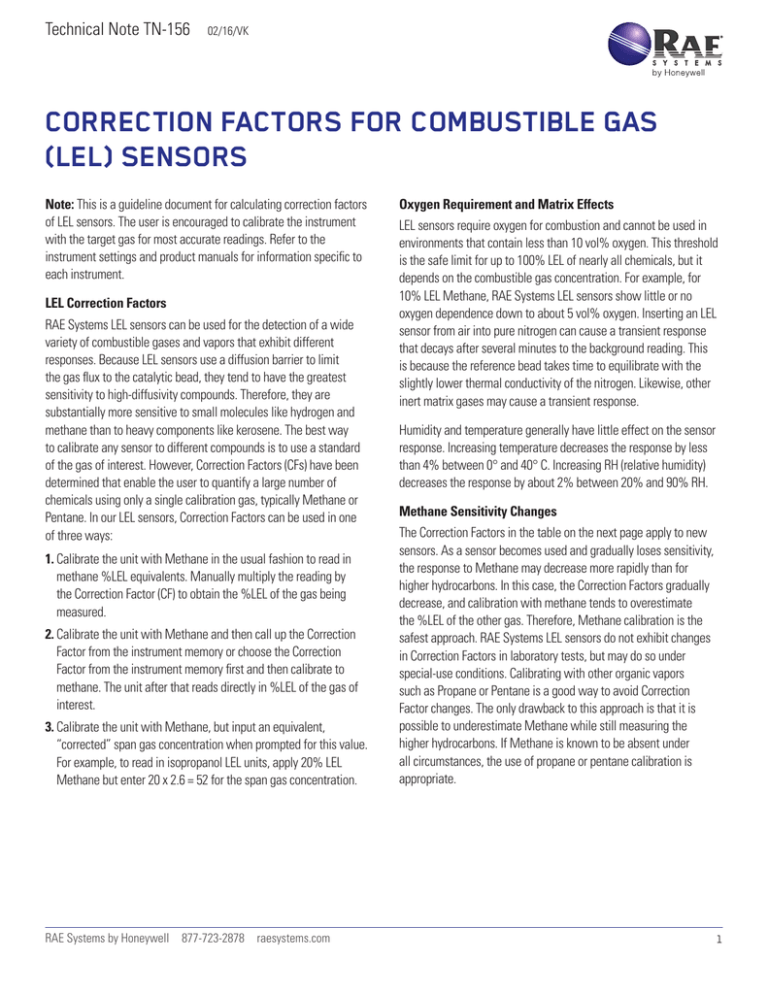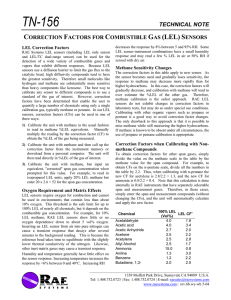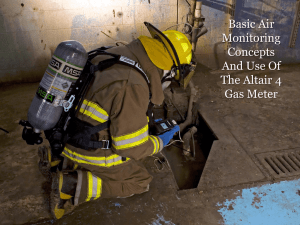correction factors for combustible gas (lel) sensors
advertisement

Technical Note TN-156 02/16/VK CORRECTION FACTORS FOR COMBUSTIBLE GAS (LEL) SENSORS Note: This is a guideline document for calculating correction factors of LEL sensors. The user is encouraged to calibrate the instrument with the target gas for most accurate readings. Refer to the instrument settings and product manuals for information specific to each instrument. LEL Correction Factors RAE Systems LEL sensors can be used for the detection of a wide variety of combustible gases and vapors that exhibit different responses. Because LEL sensors use a diffusion barrier to limit the gas flux to the catalytic bead, they tend to have the greatest sensitivity to high-diffusivity compounds. Therefore, they are substantially more sensitive to small molecules like hydrogen and methane than to heavy components like kerosene. The best way to calibrate any sensor to different compounds is to use a standard of the gas of interest. However, Correction Factors (CFs) have been determined that enable the user to quantify a large number of chemicals using only a single calibration gas, typically Methane or Pentane. In our LEL sensors, Correction Factors can be used in one of three ways: 1.Calibrate the unit with Methane in the usual fashion to read in methane %LEL equivalents. Manually multiply the reading by the Correction Factor (CF) to obtain the %LEL of the gas being measured. 2.Calibrate the unit with Methane and then call up the Correction Factor from the instrument memory or choose the Correction Factor from the instrument memory first and then calibrate to methane. The unit after that reads directly in %LEL of the gas of interest. 3.Calibrate the unit with Methane, but input an equivalent, “corrected” span gas concentration when prompted for this value. For example, to read in isopropanol LEL units, apply 20% LEL Methane but enter 20 x 2.6 = 52 for the span gas concentration. RAE Systems by Honeywell 877-723-2878 raesystems.com Oxygen Requirement and Matrix Effects LEL sensors require oxygen for combustion and cannot be used in environments that contain less than 10 vol% oxygen. This threshold is the safe limit for up to 100% LEL of nearly all chemicals, but it depends on the combustible gas concentration. For example, for 10% LEL Methane, RAE Systems LEL sensors show little or no oxygen dependence down to about 5 vol% oxygen. Inserting an LEL sensor from air into pure nitrogen can cause a transient response that decays after several minutes to the background reading. This is because the reference bead takes time to equilibrate with the slightly lower thermal conductivity of the nitrogen. Likewise, other inert matrix gases may cause a transient response. Humidity and temperature generally have little effect on the sensor response. Increasing temperature decreases the response by less than 4% between 0° and 40° C. Increasing RH (relative humidity) decreases the response by about 2% between 20% and 90% RH. Methane Sensitivity Changes The Correction Factors in the table on the next page apply to new sensors. As a sensor becomes used and gradually loses sensitivity, the response to Methane may decrease more rapidly than for higher hydrocarbons. In this case, the Correction Factors gradually decrease, and calibration with methane tends to overestimate the %LEL of the other gas. Therefore, Methane calibration is the safest approach. RAE Systems LEL sensors do not exhibit changes in Correction Factors in laboratory tests, but may do so under special-use conditions. Calibrating with other organic vapors such as Propane or Pentane is a good way to avoid Correction Factor changes. The only drawback to this approach is that it is possible to underestimate Methane while still measuring the higher hydrocarbons. If Methane is known to be absent under all circumstances, the use of propane or pentane calibration is appropriate. 1 Technical Note TN-156 02/16/VK Correction Factors when Calibrating with Non-methane Compounds To obtain Correction Factors for other span gases, simply divide the value on the methane scale in the table by the methane value for the span compound. For example, to obtain CFs on the n-pentane scale, divide all the numbers in the table, column LEL CF by 2.1. Chemical Acetaldehyde 100% LEL (Vol%) LEL CF* QRAE 3 MicroRAE CF 4 1.7 1.9 4.1 Thus, when calibrating with n-pentane the new CF for ammonia is 1 /2.1 = 0.48. Note that this calculation is done internally in RAE Systems instruments that have separately selectable span and measurement gases. Therefore, in these cases, simply enter the span and measurement compounds (without changing the CFs), and the unit automatically calculates and applies the new factor. 100% LEL (Vol%) LEL CF* QRAE 3 Dioxane, 1,4- 2 2.4 3.0 3 1.4 1.4 1.4 Chemical MicroRAE CF 4 2.5 3.6 6.9 Ethane Acetic Anhydride 2.7 2.7 3.5 6.6 Ethanol 3.3 1.8 2.9 3.1 Acetone 2.5 1.9 2.1 4.6 Ethene 2.7 1.3 1.3 1.3 Acetonitrile 3 1.7 1.9 Ethyl acetate 2 2.4 2.7 5.2 Acetylene 2.5 2.9 1.5 1.6 Ethyl benzene 0.8 2.7 3.5 6.6 Allyl Alcohol 2.5 2.1 3.1 4.1 Ethyl bromide 6.8 2.6 2.7 Ammonia 15 1.0 1.3 Ethyl chloride 3.8 2.0 2.1 1.9 2.2 2.3 Acetic acid Aniline 1.3 6.3 5.0 9.6 Ethyl ether Benzene 1.2 2.1 2.7 5.0 Ethylamine 3.5 1.7 1.9 2 1.8 1.9 3.3 Ethyl formate 2.8 2.2 2.4 Butane, i- 1.8 1.7 1.8 Ethyl mercaptan 2.8 2.0 2.2 Butane, n- 1.9 1.9 2.0 2 1.9 2.0 Butanol, i- 1.7 2.3 3.1 1.2 2.8 3.6 Butanol, n- 1.4 2.8 3.5 Butadiene, 1, 3- 2.0 Ethyl methyl ether Ethyl pentane 3.6 Ethylene oxide 2.8 3 1.7 1.9 1.3 2.6 3.2 4.9 1.1 2.5 3.0 3.7 2 2.3 2.6 Butanol, t- 2.4 2.2 2.7 Gasoline, Butene-1 1.6 1.9 1.9 Heptane, n- Butene-2, cis 1.7 1.9 1.9 Hexadiene, 1,4- Butene-2, trans 1.8 1.9 2.0 Hexane, n- 1.1 2.1 3.0 Hydrazine 2.9 4.7 5.1 Hydrogen 4 1.0 3.1 Butyric acid 2.4 3.4 2 3.7 4.2 Carbon monoxide 12.5 1.3 1.3 Carbonyl sulfide 12 1.9 1.9 Hydrogen cyanide 5.6 1.6 2.1 Isobutene (Isobutylene) 1.8 1.6 2.4 1.9 Isopropanol 2 2.2 3.2 4.3 Methane 5 1.0 1.0 1.0 1.3 Chlorobenzene 1.3 3.7 4.2 Chloropropane, 1- 2.6 2.2 2.4 Cyanogen 6.6 1.8 1.8 Cyclohexane 1.3 2.1 2.5 Cyclopropane 2.4 1.6 1.7 Decane, n- 0.8 3.3 3.9 Dichloroethane, 1,2- 6.2 5.4 2.6 2.3 Dichloromethane 13 2.3 2.4 2.2 Diisobutyl ketone 0.8 3.2 3.8 Dimethyl sulfide 2.2 2.0 2.2 Dimethylbutane 1.2 2.3 2.5 Dimethylpentane, 2,3- 1.1 2.5 2.8 8.1 3.2 RAE Systems by Honeywell 877-723-2878 raesystems.com 2.2 6 1.6 2.9 4.0 Methyl acetate 3.1 2.2 2.4 4.7 Methylamine 4.9 1.4 1.6 Methyl bromide 10 2.4 2.5 2.2 Methyl chloride 8.1 1.8 1.8 1.6 Methyl ether 3.4 1.7 1.7 4.3 Methyl ethyl ketone 1.4 2.2 2.7 5.8 Methyl formate 4.5 1.9 2.2 Methanol 2 Technical Note TN-156 02/16/VK 100% LEL (Vol%) LEL CF* QRAE 3 100% LEL (Vol%) LEL CF* QRAE 3 Methyl hexane 1.2 2.5 2.9 2.2 2.1 3.1 Methyl mercaptan 3.9 1.7 1.9 2 1.6 1.6 Methyl n-propyl ketone 1.2 2.4 3.0 Propyl ether, iso- 1.4 2.5 2.7 Propylamine, n- 2 1.9 Methyl propionate 2.5 2.4 2.3 2.7 Methylcyclohexane 1.2 Propylene oxide 2.3 1.9 2.2 2.5 3.0 Methylpentane Propyne 1.7 1.6 1.7 1.2 2.3 2.6 Toluene 1.1 2.4 2.7 Napthalene 0.9 6.5 5.0 Triethylamine 1.2 2.5 2.9 Nitromethane 7.3 2.1 3.1 Trimethylamine 2 1.9 2.0 Nonane, n- 0.8 3.0 3.6 Trimethylbutane 1.2 2.5 2.8 Octane, n- 1 2.7 3.3 4.9 Turpentine 0.8 3.0 4.3 Pentane, n- 1.5 2.1 2.3 2.3 Vinyl chloride 3.6 2.0 2.0 Pentane, i- 1.4 1.9 2.3 Xylene, m- 1.1 2.7 6.7 Pentane, Neo- 1.4 2.1 2.2 Xylene, o- 0.9 2.8 6.8 Phosphine 1.6 1.5 1.5 Xylene, p- 1.1 2.9 6.7 Propane 2.1 1.4 1.6 Chemical MicroRAE CF Chemical Propanol, n- 2.4 9.8 Propene MicroRAE CF 1.6 6.2 1.7 * LEL CF values apply for MultiRAE families, ToxiRAE Pro and other RAE Systems instruments. Values in bold type are confirmed with RAE Systems Instruments. Others, shown in italic, are calculated from diffusion models. These correction factors are applicable for versions 1.64 for ToxiRAE Pro and 1.16 for MultiRAE. Caution! Please refer to TN-144 for compounds that may damage LEL sensors. Note: Reported values of the lower explosive limit for jet fuels range from about 0.3% to 0.9% by volume. An earlier third-party test reported a CF for jet fuels of 3.35. However, we have been unable to confirm this result and recommend using a PID as a much more accurate method of measuring LEL for jet and diesel fuels. RAE Systems by Honeywell 877-723-2878 raesystems.com 3


